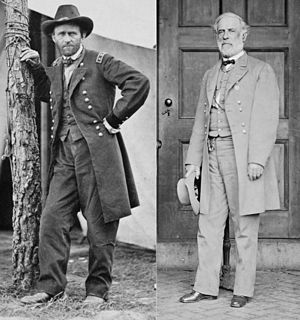
Back حملة أبوتاموكس Arabic Kampagn Appomattox Breton Appomattox-Feldzug German کمپین آپوماتوکس Persian Campagne d'Appomattox French Operasi Appomattox ID Campagna di Appomattox Italian アポマトックス方面作戦 Japanese Appomattoxveldtocht Dutch Campanha d'Appomatox Occitan
| Appomattox campaign | |||||||
|---|---|---|---|---|---|---|---|
| Part of the eastern theater of the American Civil War | |||||||
 Ulysses S. Grant and Robert E. Lee, opposing commanders in the Appomattox campaign | |||||||
| |||||||
| Belligerents | |||||||
|
|
| ||||||
| Commanders and leaders | |||||||
|
|
| ||||||
| Units involved | |||||||
|
| |||||||
| Strength | |||||||
| 114,335[3] | 56,000[4] | ||||||
| Casualties and losses | |||||||
| 10,780[5] | ~25,000; Army of Northern Virginia disbanded following Gen. Lee's surrender at Appomattox Court House (April 9). | ||||||
The Appomattox campaign was a series of American Civil War battles fought March 29 – April 9, 1865, in Virginia that concluded with the surrender of Confederate General Robert E. Lee's Army of Northern Virginia to forces of the Union Army (Army of the Potomac, Army of the James and Army of the Shenandoah) under the overall command of Lieutenant General Ulysses S. Grant, marking the effective end of the war.
As the Richmond–Petersburg campaign (also known as the siege of Petersburg) ended, Lee's army was outnumbered and exhausted from a winter of trench warfare over an approximately 40 mi (64 km) front,[notes 1] numerous battles, disease, hunger and desertion.[6] Grant's well-equipped and well-fed army was growing in strength. On March 29, 1865, the Union Army began an offensive that stretched and broke the Confederate defenses southwest of Petersburg and cut their supply lines to Petersburg and the Confederate capital of Richmond, Virginia. Union victories at the Battle of Five Forks on April 1, 1865, and the Third Battle of Petersburg, often called the Breakthrough at Petersburg, on April 2, 1865, opened Petersburg and Richmond to imminent capture. Lee ordered the evacuation of Confederate forces from both Petersburg and Richmond on the night of April 2–3 before Grant's army could cut off any escape. Confederate government leaders also fled west from Richmond that night.
The Confederates marched west, heading toward Lynchburg, Virginia, as an alternative capital. Lee planned to resupply his army at one of those cities and march southwest into North Carolina where he could unite his army with the Confederate army commanded by General Joseph E. Johnston. Grant's Union Army pursued Lee's fleeing Confederates relentlessly. During the next week, the Union troops fought a series of battles with Confederate units, cut off or destroyed Confederate supplies and blocked their paths to the south and ultimately to the west. On April 6, 1865, the Confederate Army suffered a significant defeat at the Battle of Sailor's Creek, Virginia, where they lost about 7,700 men killed or captured and an unknown number wounded. Nonetheless, Lee continued to move the remainder of his battered army to the west. Soon cornered, short of food and supplies and outnumbered, Lee surrendered the Army of Northern Virginia to Grant on April 9, 1865, at the McLean House near the Appomattox Court House, Virginia.
- ^ a b c Further information: Union forces organization during the campaign (Official Records, Series I, Volume XLVI, Part 1, pp. 564–580).
- ^ Further information: Confederate forces organization during the campaign (Official Records, Series I, Volume XLVI, Part 1, pp. 1267–1276).
- ^ Official Records, Series I, Volume XLVI, Part 1, p. 62
- ^ Calkins, Chris. The Appomattox Campaign, March 29 – April 9, 1865. Conshohocken, PA: Combined Books, 1997. ISBN 978-0-938-28954-8. p. 63 gives Lee's strength at the beginning of the Appomattox Campaign as 55,000–58,000 effectives, which would include the defenders of Richmond and Pickett's task force of 10,600 men sent to Five Forks.
- ^ Official Records, Series I, Volume XLVI, Part 1, p. 597
- ^ Wyrick, William. The Confederate Attack and Union Defense of Fort Stedman: March 25, 1865. Chapter 4 in Bearss, Edward C. with Bruce Suderow. The Petersburg Campaign: The Western Front Battles. Savas Beattie: El Dorado Hills, CA, 2014. ISBN 978-1-61121-104-7. pp. 241, 245.
Cite error: There are <ref group=notes> tags on this page, but the references will not show without a {{reflist|group=notes}} template (see the help page).